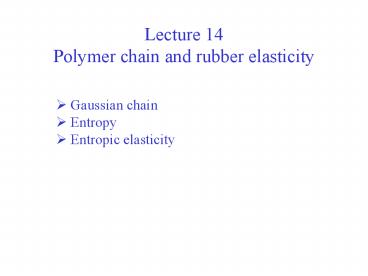ENGR-1100 Introduction to Engineering Analysis - PowerPoint PPT Presentation
1 / 10
Title:
ENGR-1100 Introduction to Engineering Analysis
Description:
End to end distance ... The average end to end distance is zero but the ... When we pull the ends of the polymer chain, an average force we need to exert to ... – PowerPoint PPT presentation
Number of Views:192
Avg rating:3.0/5.0
Title: ENGR-1100 Introduction to Engineering Analysis
1
Lecture 14 Polymer chain and rubber elasticity
- Gaussian chain
- Entropy
- Entropic elasticity
2
Freely jointed chain
Model N1 beads (mers) connected by N links
(bonds) of length b0. Vector representing nth
link
End to end distance Since link orientations
are random an average over all conformations
(denoted by )
3
End to end distance
The average end to end distance is zero but the
average distance square is not - it measures the
size of the polymer coil . The last equality
comes for the fact that the average dot product
of two randomly oriented vectors is zero Real
chains are typically more rigid than model chains
4
Distribution of distances
Probability of a given conformation is a product
of probabilities for each link (they are
independent . With a single link probability
of given direction given by
5
Distribution of distances - II
Probability that a chain has end to end distance
R Using integral representation of the delta
function We get
6
One integral
Therefore
7
Distribution - final form
For small For large the above Eq. is
also quite OK for large N since both sides are
very small. With the above approximation
8
Probability and Entropy
When we calculated probability we counted number
of configurations with a given end to end
distance. Thus by definition in microcanonical
ensemble, the associated entropy is Where k
is the Boltzmann constant, and the Hemholz free
energy
9
Entropic spring
When we pull the ends of the polymer chain, an
average force we need to exert to stretch the
chain end to end distance is The above
formula is like a spring with a spring constant
10
Rubber elasticity
Polymer chains connected to cross links A
simple estimate gives entropic contribution to
modulus Where kc is the spring constant, lc
is the distance between cross links, Nc is a
number of monomers between cross links and nc is
the cross link density































